The first part of this article concerns two influential motoring organizations with very different backgrounds and fascinating histories, followed by a look at law enforcement officers and some of their vehicles.

The Automobile Association (AA) was founded in 1905, originally with a membership of just 90, which has now grown to 15 million. They started using bicycles followed by motorcycle combination patrols, then moved on to cars and now use sophisticated vans. Initially the business focused on breakdown cover which continues to this day. However they have since diversified significantly and nowadays offer finance, driving lessons, motoring maps, insurance, leisure and lifestyle services. The AA employs over 7,400 people and is headquartered at Fanum House, Basingstoke.
The Royal Automobile Club (RAC) was founded in 1897 as a private social and athletic club. In the early 1900s it was influential in working with the government to amend out-of-date speed limits and advise on other issues. They organized the first British Grand Prix at Brooklands in 1926 also the first RAC Rally, now Rally GB, in 1932 and were influential in many more motorsport events. They remained a respected voice in the development of government policy for roads and motor transport.
In 1901 an associate section (RAC Motoring Services) was formed and had uniformed mobile patrols using Matchless motorcycle combinations. The sidecars contained a tool kit, fan belts, hoses and cans of spare petrol. Initially they used to park up in laybys and alongside major road junctions, and from 1957 were supplied with two-way radios which significantly helped getting to stranded motorists. In 1978 the RAC Motoring Services was split off from the parent company to form the RAC Motoring Services Ltd. which was sold to Lex Services in 1999. After a number of other changes it is now RAC plc with its headquarters in Walsall, West Midlands and employs 3700 staff.
Both the AA and the RAC used to operate their own very distinctive roadside telephone boxes for use by their members in the event of a breakdown or an emergency. There was some cooperation between the two organizations, with the access keys to all these boxes having a common key pattern.
The AA Patrolmen

Dinky Toys and Somerville Models AA patrolmen.
Two designs of AA guides were made by Dinky Toys; the 44C figure who was directing traffic and the 44D figure who was saluting. They were introduced in the October 1935 edition of Meccano Magazine priced at 3d (pence) each and remained in the range until 1940. Both figures are 36mm high and sport a brown uniform with a black sash, brown peaked caps and black knee length boots. The 44C has white gloves while the 44D has no gloves. Neither of these figures were released again by Meccano after the war.
It was the practice in the early days of the AA for patrolmen to salute a passing motorist who was displaying their membership badge on the front of their vehicle. The other Dinky figure shows a patrolman directing traffic. This was showed to very good effect during the coronation of Queen Elizabeth II; the police concentrated on security and the AA were called upon to manage temporary road signing, parking facilities and traffic control.
Doug McHard was the Editor of Meccano Magazine in the early 1970s and later the Marketing Director of the Meccano and Dinky Toys ranges. When he left Meccano he was allowed to take a number of molds of Hornby/Dinky figures with him. In 1978 he set up Somerville Models in Lincolnshire and specialized in producing low-volume, high-quality diecast model cars.
He did some test casts of the figures with a view to possibly selling them but these plans never materialized. Two of the castings he acquired were of the pre-war AA patrolmen and two examples which were recently sold at auction are shown above. For some reason these never went into production and the two figures shown here are test castings.
The painting of the Somerville figures has a slightly higher level of detail, and the uniforms are of a brighter color. From memory I believe that the color of the Dinky versions is more accurate to the original AA uniforms.
The AA Roadside Telephone Box was introduced in October 1935 and remained available until 1940. It’s a lovely model made from tinplate and was never reissued after the war. The design is exquisite and comprises a beige chamfered base. The box body is colored yellow, black and white and the roof is white. A wire flagpole is located on the top and supports three tinplate direction signs; one for London, one for Glasgow and one for Liverpool. Being tinplate it is prone to rust and these are hard to find in any condition.

The AA roadside telephone box.
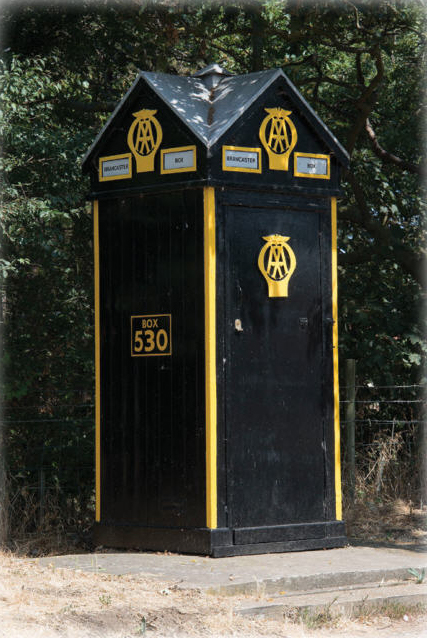
A preserved AA box at Brancaster.
The AA first introduced roadside boxes in 1912. They were intended for use as shelters by the Patrolmen, but were soon equipped with telephones. The new larger boxes were introduced in 1925. They were illuminated by lamps on the roof and incorporated a telephone and include a fire extinguisher for use by members and Patrolmen. Each box was numbered and the AA website lists a total of 862 in use by 1962 throughout Great Britain. In 1947, AA and RAC box keys were made interchangeable. Now only 19 boxes survive, eight of these are listed buildings. The one shown above is in a lay-by and is number 530 at Brancaster, Norfolk, on the A149 (Hunstanton-Wells) around 300 yards west of the junction with Common Lane, Brancaster Staithe. My old AA key is shown below but I doubt if it will now fit the box at Brancaster.
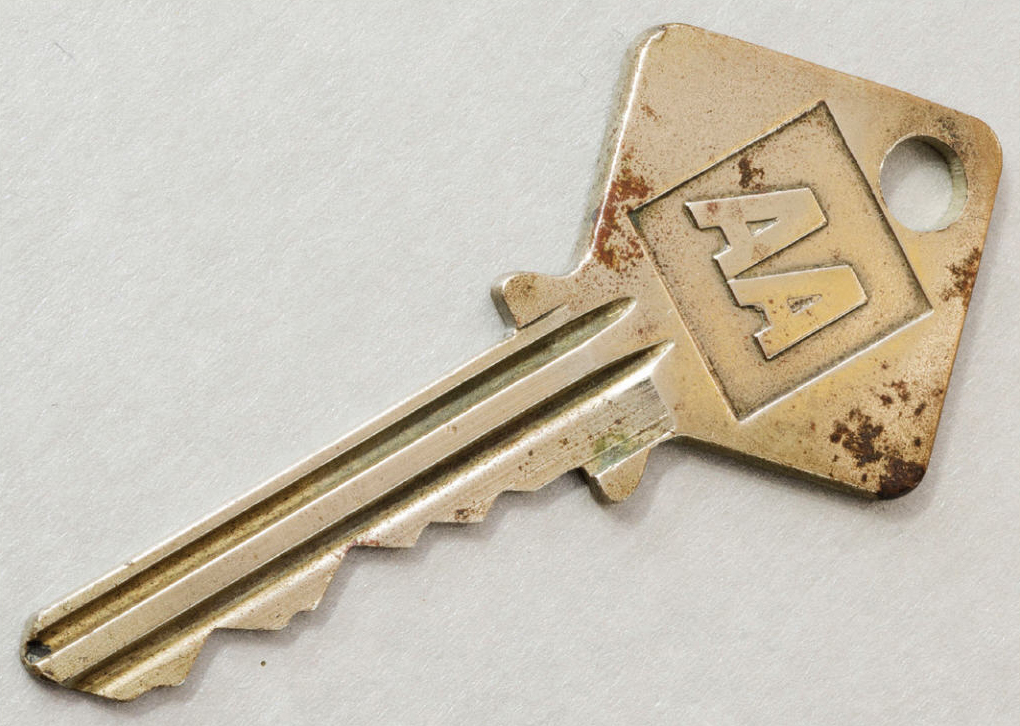
A key for AA and RAC roadside boxes.
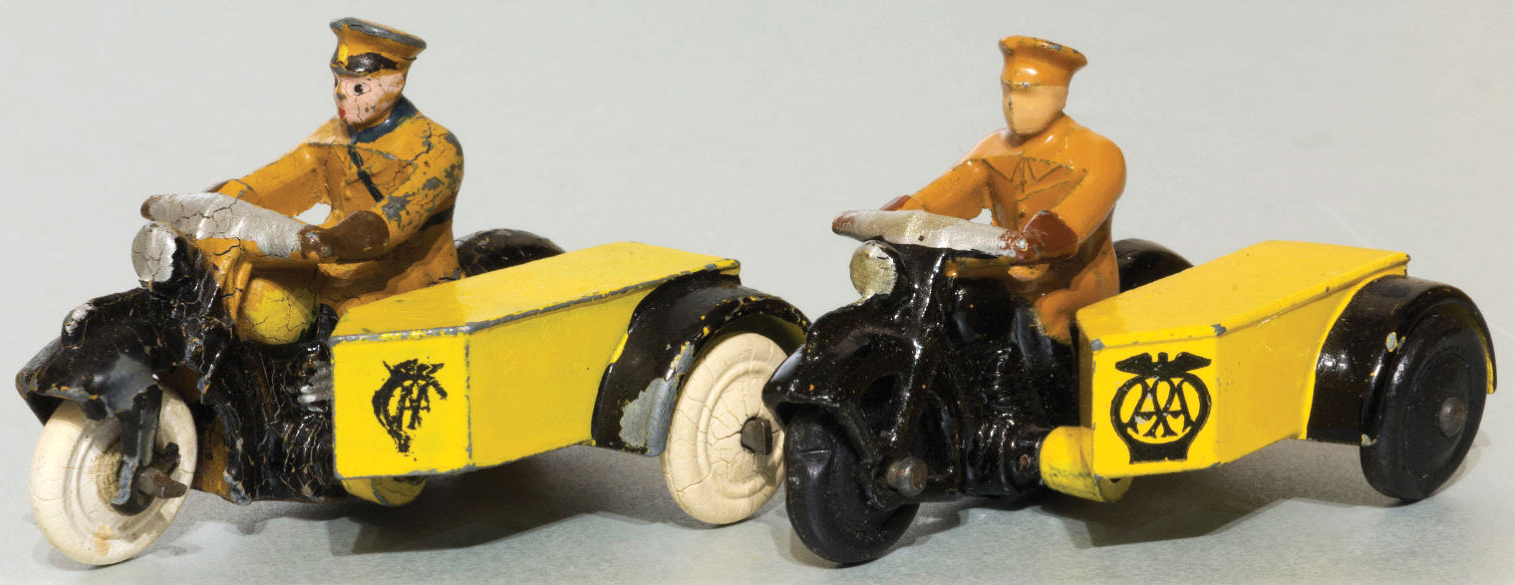
Dinky 44B AA motorcycle combinations.

Dinky 270 AA Motor Cycle Patrol trade box.

Different versions of the AA logo over a period of 25 years.
When the AA was formed in 1905 the Patrolmen used bicycles but everything changed in the 1920s when motorcycle and sidecar combinations were introduced. This meant a more rapid response and enabled tools and spares to be carried in the sidecar. The AA motorcycle was a 2.5hp Chater Lea, who had a factory in Banner Street, London EC1. These were later superseded by Triumph and BSA models.
The Dinky Toys AA Motorcycle Patrol was introduced in 1935 as catalogue number 44B. The advent of WWII caused this model to be discontinued in 1940. The motorcycle is 45mm long. The first versions were fitted with solid white rubber tires and they were reintroduced in 1946 with black rubber tires until 1950. All the Dinky motorcycles are made to a generic design and the AA version incorporates a rider in a tan uniform. The motorcycle is black and the sidecar is yellow with an AA sign on the front.
The combination was reintroduced in 1959 as catalog number 270 and remained in the range until 1962. Some had black rubber wheels that were later replaced with grey plastic wheels. The AA updated their logo on a number of occasions and the Motorcycle Patrol can be found with four different versions between 1935 and the 1960s. For more details of the AA logo history see the article A sign of membership at the AA website.
This model was available individually and was sold out of a dealer trade box which would have initially contained 6 models. In addition to the AA version there were two other variants available for export markets only. They were the number 271 “TS” (Touring Secours) for the Belgian market and the number 272 “ANWB” (Algemene Nederlandse Wielrijdersbond) for the Netherlands market. These are quite rare in the UK.

Different versions of the AA logo over a period of 25 years.
Before the war all the AA models were available in the number 44 AA Box, Motor Cycle Patrol and Guides Gift Set (shown above) which was available from 1935 to 1941. This comprised the 44A AA Box, the 44B Motor Cycle Patrol, the 44C and the 44D AA Guides. These were set against a very attractive pictorial box insert.
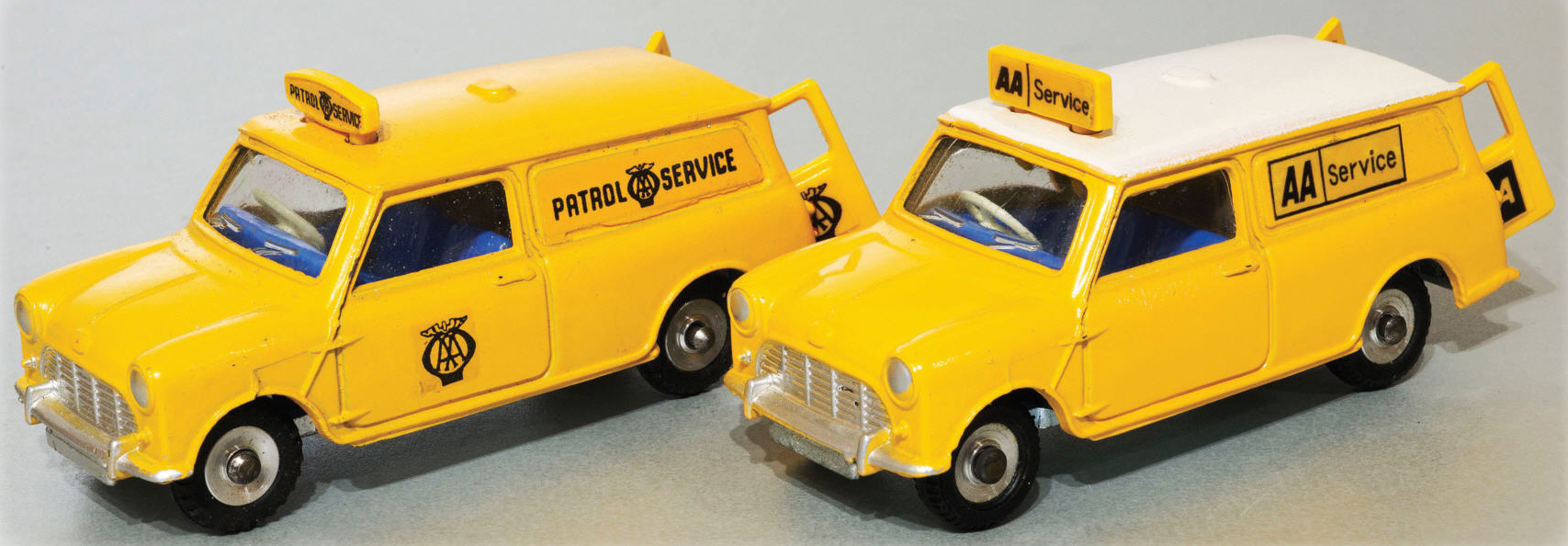
Dinky AA Mini Vans: early version on the left and the later one on the right.
In 1962 Mini Vans started to replace the motor cycle combinations and were soon seen throughout England. Scotland had a fleet of Land Rovers. I’m sure these would have been very well received by the Patrolmen, especially during the winter months.
The Austin and Morris Mini Vans were introduced in 1960 and these very popular vehicles remained available until 1983. The van was renamed to just Mini Van in 1978. During the 23 years of production over 520,000 were made. It had a 4 cylinder 848cc engine, independent suspension and front wheel drive. It was built on the longer Mini Traveller chassis and had a carrying capacity of ¼ ton and a maximum speed of 73mph. The first 200 vans were handed over to the AA on 26 March 1964.
The earlier motorcycle and sidecar combinations carried 29 items of equipment, including two red flags. The mini van carried 97 items of equipment, including two red flags. The number 274 Dinky Mini Van was introduced in July 1964 and remained in the range until 1970. This truly is a delightful model with many excellent details. These include a detailed diecast base plate, accurate yellow paintwork (later yellow with a white roof), a pair of opening rear doors, a roof sign, a roof ventilator, window glazing, an interior including seats and a steering wheel, spun alloy wheels, spring suspension and steerable front wheels. The interior seats can be either red or blue. On a model that is only 3” (78mm) long this is diecasting at its absolute best.
The RAC Patrolmen

Dinky Toys and Somerville Models RAC patrolmen.
Two designs of RAC guides were made by Dinky Toys using the same molds as the AA figures; the 43C figure who was directing traffic and the 43D figure who was saluting. They were introduced in the October 1935 edition of the Meccano Magazine priced at 3d (pence) each, and remained in the range until 1940. Both figures are 36mm high, have a blue uniform with a red sash, blue peaked caps and black knee length boots. The 43C has white gloves whereas the 43D has no gloves. Neither of these figures were released again by Meccano after the war. Somerville Models also reproduced these two figures, details as per the AA patrolmen covered above.
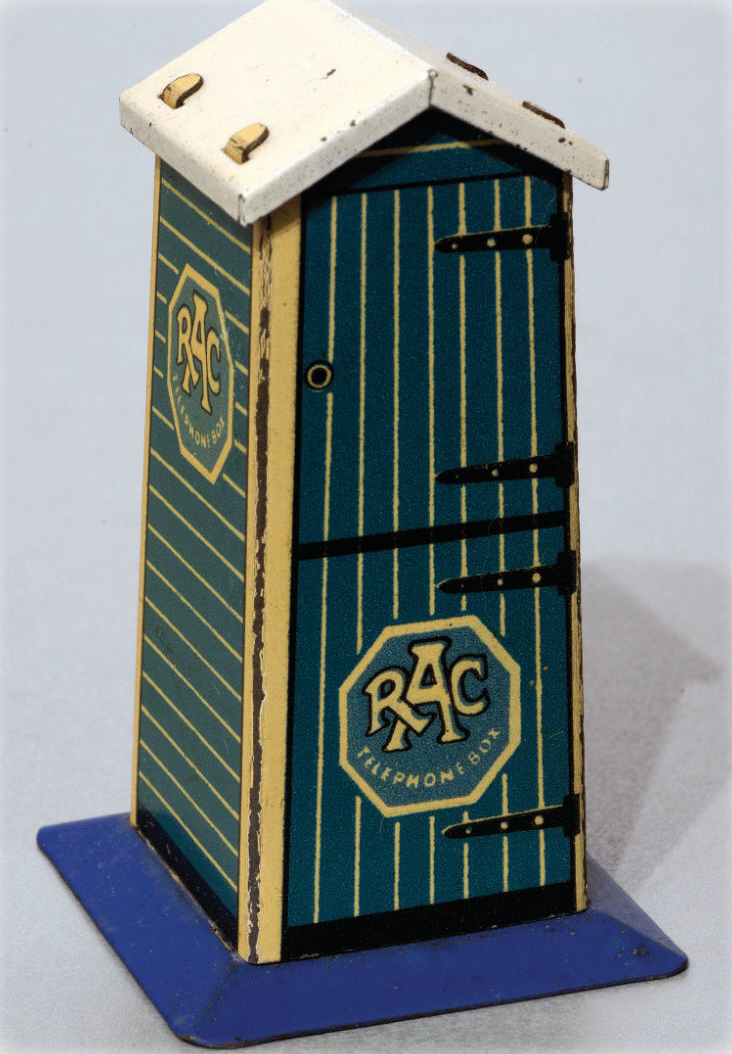
The RAC roadside telephone box.
The 43A RAC Telephone Box was introduced in October 1935 and remained in the range until 1941. It is made from tinplate and is a lot more simple than the AA version. Standing on a blue base, it is printed blue and cream with black hinges and has a white roof. The base is 30mm x 30mm and the box is 51mm in overall height. Like the AA Box, being tinplate it is prone to rust and these also are hard to find in any condition.
The RAC Boxes started to appear in 1912 and initially were shelters for patrolmen to be used in poor weather. The boxes fitted with telephones appeared around 1930 and members were issued with keys to gain access in case of a problem. At their height there were approximately 500 boxes throughout the country. Their demise was caused by the rapid uptake of mobile phones.
The boxes were made from timber with a two-part stable door. The location of the box was clearly shown and they were provided with first-aid kits and petrol cans. The only surviving RAC Boxes are to be found in Heritage museums; there is one located in the East Anglia Transport Museum at Carlton Colville, Lowestoft, Suffolk.

Pre-war and post-war Dinky 43B RAC motorcycle combinations.

RAC Motor Cycle Patrol trade box.
The 43B RAC Motor Cycle Patrol was introduced in 1935 and discontinued in 1940. The motor cycle was painted black and the sidecar was dark blue. This was a different design from the AA sidecar and the tires are usually solid white rubber. The motor cycle is 45mm long. Oddly, the Dinky RAC sidecar is plain blue with no RAC logo. In real life all of them were clearly marked as RAC vehicles. It’s not known why Meccano made this surprising omission. The combination was re-released after the war between 1946 and 1949. The level of painting detail of the driver is much greater on the pre-war vehicle than the later version and the tires are solid black rubber. When sold individually the RAC motor cycle was delivered to dealers in a trade box initially containing six models.

RAC Gift Set.
Image: Vectis Auctions
Before the war all the RAC models were available in the number 43 RAC Box, Motor Cycle Patrol and Guides Gift Set which was
available from 1935 to 1941. This comprised the 43A RAC Box, the 43B Motor Cycle Patrol, and the 43C and 43D RAC Guides. These were set against a very attractive pictorial box insert. The RAC gift sets seem much rarer than the AA versions and quite hard to find.
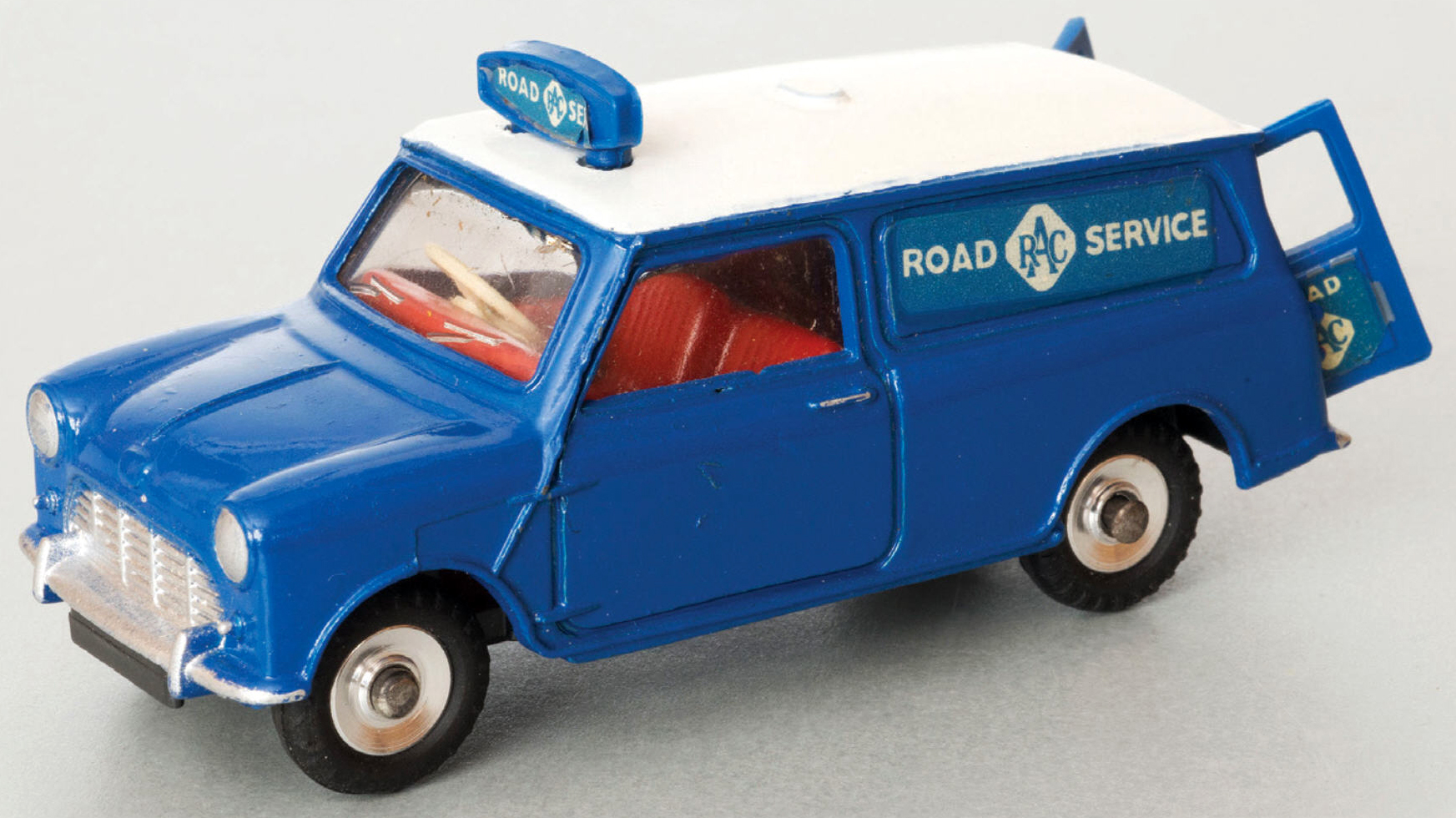
RAC Mini Van.
The 273 Mini Minor Van RAC was introduced in December 1965 and remained in the range until 1970. It is an identical casting to the 274 AA van described earlier.
The differences are that it is painted dark blue with a white roof and a blue roof sign and has RAC markings on the roof sign, rear panel and rear doors. The interior seats can be either red or blue. The style of the RAC logo and markings did not change throughout the lifetime of the model.
Policemen and Police Cars
The range of Dinky policemen and accessories was first announced in the July 1936 edition of the Meccano Magazine and the advert is shown below. In those days, for Dinky Toys there was no specific promotion, new items were simply added in to the existing range with no fanfare whatsoever.

Advertisement in the July 1936 issue of Meccano Magazine
announcing the police related models.
There were two different designs of Policemen made by Dinky, both of them were on point duty (traffic control). The number 42c is in a white coat with a blue helmet and trousers with an overall height of 42mm. The number 42d is in a blue uniform, blue helmet and long white gloves which reach down to the elbows, he is 40mm high. Both figures were new in July 1936 and discontinued in 1941. Neither of these figures reappeared after the war. Modern versions of the policemen were trialed by Somerville Models and these are shown below.

Dinky policemen: on the left three Dinky figures, on the right two Somerville figures.
The Police Box or Hut was introduced in July 1936 as catalog number 42a and was discontinued in 1941. It was released again after the war from 1948 to 1960 with the catalogue number changing to 751 in 1954. It has an overall height of 54mm.

The Dinky Police Hut and the dealer trade box. By the mid 1960s, thanks to Dr. Who, these police boxes became known as the Tardis figures.
This is probably the best known Dinky Toy of all as it has become synonymous with the extremely popular BBC series ‘Dr. Who’ and his time machine the Tardis.
The Box is painted dark blue with silvered windows and a ‘Police’ sign at the top on all four sides. On top of the roof is a light, this is sometimes painted blue and sometimes red.
Under the left hand window on the front is a hinged panel, behind this is a telephone for use by the public. Underneath this is a panel containing instructions for use and alongside this is a ventilator. These three features are silvered.
The Police Box that the Dinky model is based on was designed by The Dinky Police Hut and the dealer trade box. By the mid 1960s, thanks to Dr. Who, these Police boxes became known as the Tardis Gilbert MacKenzie Trench and was in use from the late 1920s until the late 1960s. Not all the boxes were painted blue, some were green and some red.
The public could use the box to contact the police via a hinged panel which revealed a telephone. A policeman could physically enter the box which was in fact a miniature police station, there he could read and write reports, contact the station and take meal breaks in private.
The box contained a first aid kit and a fire extinguisher, if the light on the roof was flashing this alerted a policeman that he was required to contact his station immediately.
At one time there were thousands of these boxes but with the advent of modern communications they have all now sadly disappeared from our streets. There are some preserved boxes in museums.

The police motorcycles.
Shown in the image above are the 37B Police Motor Cyclist, the pre-war 42B Police Motor Cycle Patrol and the 42 post-war Police Motor Cycle Patrol.
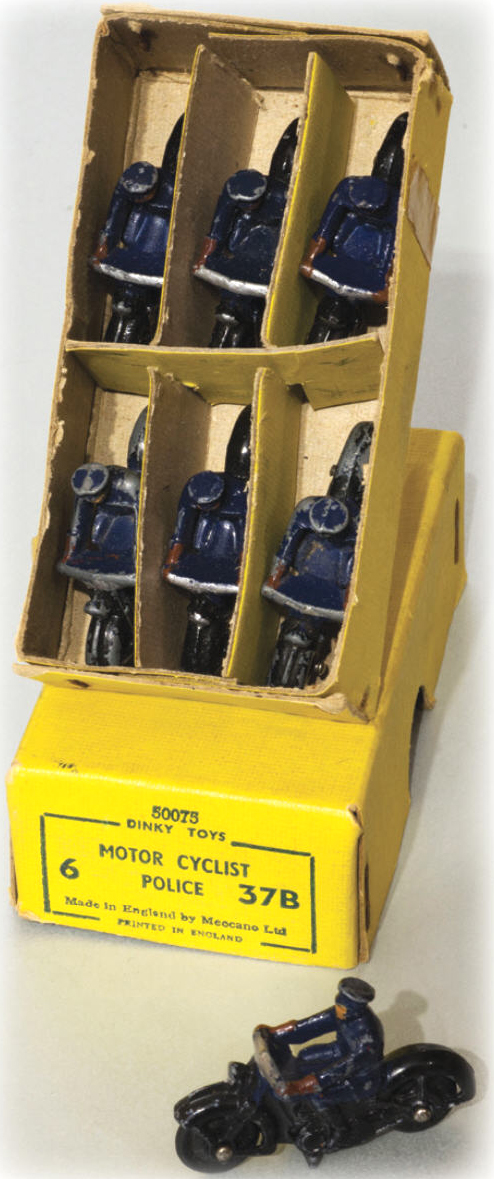
Police motorcycles trade box.
The 37B was new in November 1937 and discontinued in 1941. It was reissued after the war in 1948 until 1954 but only as an export item for the U.S. market. The motorcycle is black with silver handlebars and the rider is in a blue uniform with brown gauntlets. The overall length is 45mm. This casting was used for all the motorcycles in the Dinky range with only a minor change to accommodate the sidecars when used as a combination. The 37B was only sold from a dealer trade box containing six models.
The pre-war number 42b Police Motor Cycle Patrol was introduced in 1935 and remained available until 1940. The motorcycle is painted black with a silver exhaust and the rider and passenger are both in dark blue uniforms with detailed painting of the faces. The sidecar is painted green and some have white rubber wheels while later models sport black wheels. This model was reissued after the war between 1948 and 1954 as an export only item to the United States. This had simplified paintwork, no silver on the exhaust and no detailing in the faces. It was fitted with black rubber wheels.

Number 42 Police Gift Set.
The No. 42 “Police Box, Motor Cycle Patrol and Policemen” Gift Set was introduced in 1935 and remained available until 1940, it was never reissued after the war. It contained the 42A Police Box, the 42B Police Motor Cycle Patrol and the two Policemen 42C and 42D. It was contained in a blue lift-off lid box and the models were shown against an attractive display card in the box base.

Number 42 Police Gift Set.
The Dinky Toy range from the early 1930s always contained an ambulance and a fire engine but very surprisingly they never featured a police car until 1955. This was an amazing omission as all the other diecast toy manufacturers in the UK featured one in their ranges. Dinky had no shortage of suitable saloon cars in their catalogue which could have easily been offered as police vehicles with a simple alternative color scheme. I’m sure that such a vehicle would have been a good seller.
The first such Dinky vehicle was the number 255 Mersey Tunnel Police Van which was new in September 1955 and available until 1961. This iconic vehicle, painted bright red, was based on a short wheelbase Land Rover (Series 1) and would have been familiar to young boys from Liverpool and other visitors to the city. Even though the real vehicle would never have been seen by the vast number of boys in other parts of the country, it was still a very popular model and a firm favorite of mine at the time. This was the only unique casting of a police vehicle made by Dinky. All the other examples are modifications of existing cars in the range.
The next model was the number 256 Humber Hawk Police Car, new in December 1960 and available until 1964. This was a lovely model painted black and included a roof sign, an antenna, spring suspension and glazed windows. It also had interior seating, a steering wheel plus a driver and policeman passenger. The Humber Hawk was a substantial vehicle made by the Roots Group and an excellent choice for an emergency vehicle.
Britain’s motorway network commenced in 1958 with the Preston Bypass (M6), and the first part of the M1 was opened in 1959. This presented the police with a problem as there were no speed restrictions in the early days and the bad guys would use fast cars to get away from the law. The response was the introduction of specialist faster police vehicles and Dinky announced the number 269 Jaguar Motorway Police Car in April 1962, which remained available until 1966. This is painted white and features an antenna, a roof mounted blue light, a ‘Police’ sign on the boot lid, steering and suspension, window glazing, seating, steering wheel and a driver and policeman passenger. Some of these vehicles are painted using gloss white paint and some with matt paint.
We started this part of the article with two policemen on point duty and we now finish with the last Dinky Toy to offer a very similar function but using a completely different design. The number 753 Police Controlled Crossing was new in November 1962 and stayed in the range until 1967. I quote from the November 1962 issue of Meccano Magazine:
This delightful little miniature, manufactured from high-impact polystyrene, has a policeman who can be turned around in his box by means of a knurled knob protruding at the base of the box. It is available in kit form with the lamp standard, policeman and his box being supplied separated from the base. These are easy to fix, and if required, can be glued permanently in place. A must for your layout!
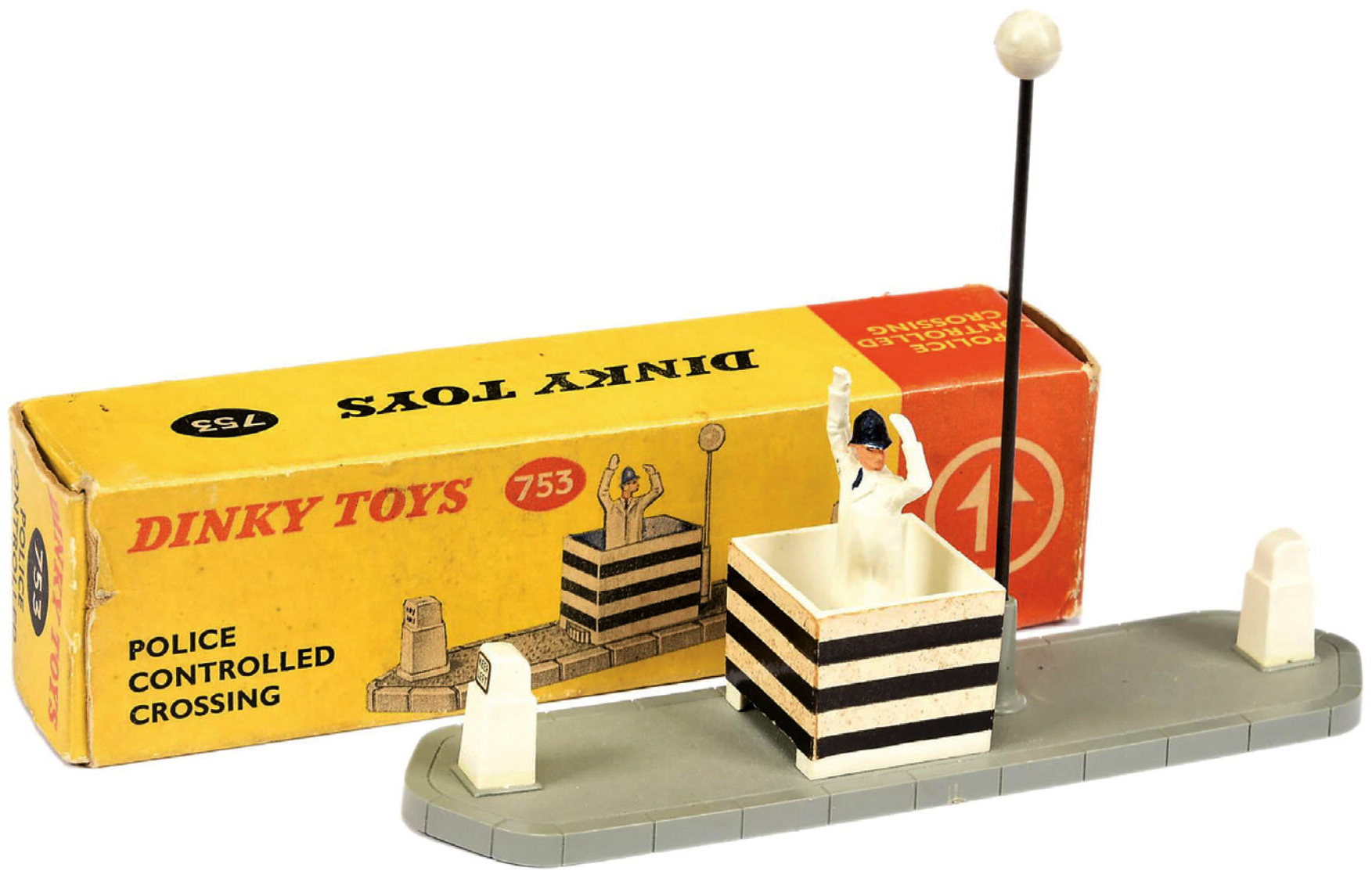
The Police Controlled Crossing.
Image: Vectis Auctions
This article concerns figures which are suitable for use with Hornby O gauge model railways and I have also included directly associated Dinky vehicles. As Hornby O gauge was discontinued in the early 1960s I have only included the Dinky vehicles made between the 1930s and the early 1960s. The Dublo Dinky range never incorporated a police car, so sadly the Hornby Dublo boys had to look elsewhere to achieve law enforcement on their layouts.
Acknowledgement
This article by our late friend Dave Busfield first appeared in the April 2020 issue of Hornby Railway Collectors’ Association Journal.